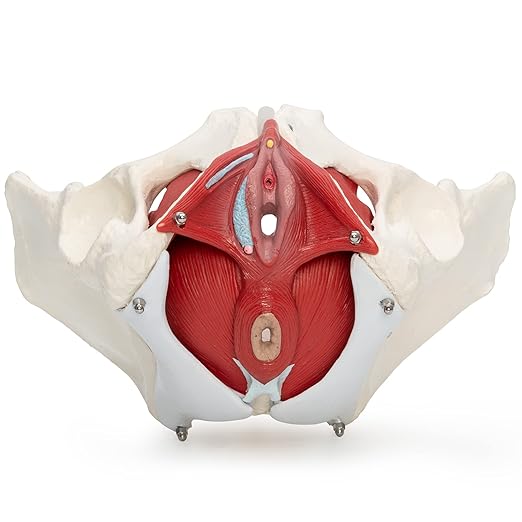About your pelvic floor…
Dumoulin and Cacciari’s 2018 systematic review, highlights that pelvic floor dysfunction (PFD) is common among postpartum women, with around 50% experiencing some form of pelvic floor issue after childbirth. Conditions like urinary incontinence, pelvic organ prolapse, and fecal incontinence are frequently reported. Pelvic floor muscle training (PFMT) was shown to significantly improve outcomes, particularly for urinary incontinence (UI), as women in the PFMT groups were much more likely to report a cure or improvement compared to those who received no treatment. The most common causes include carrying excess weight, pregnancy, childbirth, sedentary lifestyle and strenuous exercise. Understanding how these muscles work is key to preventing dysfunction!
So —
- Pelvic floor issues affect up to 50% of women after childbirth.
- The most common issues are incontinence, pelvic organ prolapse, and fecal incontinence.
- Pelvic floor retraining significantly improves these conditions!

What is the pelvic floor?
When relaxed, the pelvic floor is a sling of muscle from the pubic bone to the tailbone. The pelvic floor supports your pelvic organs, such as the bladder and bowel.
What does it do?
When contracted, the pelvic floor pulls up and into the body and clamps the urethra and rectum. The pelvic floor muscles aid urinary control, continence, and sexual function. Both men and women can experience pelvic floor weakness. As with other muscles, exercises can help the pelvic floor work properly. For women specifically, a healthy pelvic floor can lower your risk of vaginal prolapse, contribute to better bowel and bladder control, and improve recovery after childbirth. Physical therapy can address the following conditions: prenatal/postpartum care, pelvic pain, incontinence, endometriosis, irritable bowel syndrome, osteoporosis, low back pain, and musculoskeletal injuries. If you need to see a physical therapist for any of these conditions, please don’t hesitate!
Note: if you have leakage or poor control of your pelvic floor, please read my post titled Got Leaking?
The Pelvic Floor Rehab Program
The pelvic floor is a muscle group that automatically fires when we laugh, sneeze, cough, jump, run, etc. Pregnancy naturally interrupts this “reflex”. This makes sense because, during pregnancy, your pelvic floor is strained with the weight of the growing baby, and all three of your pelvic organs are stretched, pushed, and squeezed. Although this is natural and to be expected, there are some very serious implications (ie leaking and constipation) if you do not rehabilitate your pelvic floor back to health.
The Total Body Reset program is designed to help you “tune in” and engage your pelvic floor so that you can do these activities without any issues.
A Note About Pelvic Floor Exercises
I have something VERY VERY important to say about pelvic floor exercises:
The pelvic floor is a REFLEXIVE muscle group.
This means that the pelvic floor is a muscle group that automatically fires when we laugh, sneeze, cough, jump, run, etc. This means that active contraction of the muscles with Kegels will NOT help the reflex get any better at reflexing.
Many people simply need to re-educate their pelvic floor muscles to dramatically improve their symptoms. Gaining greater control by “tuning into the pelvic floor muscles” can help improve pelvic floor muscle function. Rigid (strong and wrong) contractions of both the abdominal and pelvic floor muscles can actually make the pain worse. This is one reason I do NOT endorse squeezing, bracing or tightening.
How to “Tune into” your Pelvic Floor
It takes diligence to learn how to “tune into” and feel the reflexive contraction of the pelvic floor muscles. Here are some pointers:
- Find the right muscles. To identify your pelvic floor muscles, imagine stopping urination in midstream. Did you feel that clench? Those are your pelvic floor muscles! Repeat this 5 times so that you feel the muscles contract voluntarily.
- Perfect your technique. Remember, the pelvic floor is a REFLEX. That means we need to be doing something for the muscles to engage involuntarily. I like to couple pelvic floor exercises with spine correction or “lengthening” exercises. Try this: sit up nice and tall in a chair. As you exhale, visualize your spine being lengthened upward. Now “tune into” the pelvic floor muscles by visualizing stopping just a teeny tiny drop of urine. On each exhale, “lengthen” your spine up and “tune into” your pelvic floor. Repeat four or five times in a row.
- Maintain your focus. For best results, on each exhale “lengthen” your spine and visualize stopping an even tiner drop of urine. Be careful not to tighten the muscles in your abdomen, thighs or buttocks. Avoid holding your breath. Instead, maintain proper diaphragmatic breathing during the exercises.
- Practice with Diaphragmatic Breathing. Now practice engaging your pelvic floor while you do diaphragmatic breathing. Take a deep breath from your abdomen for 2 seconds. As you exhale through pursed lips, gently engage your pelvic floor. The exhale is 4 seconds long.







